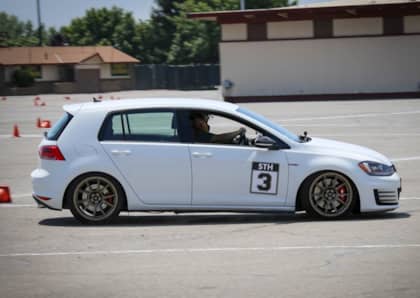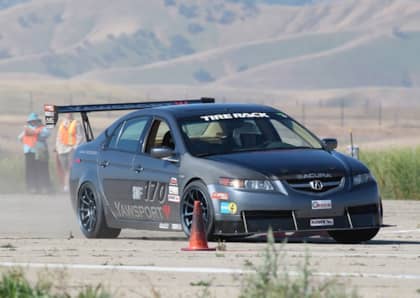Horsepower Horseplay: How I Came to Fear the Race Car & Love the Cyclekart
There are some real problems with racing. Yeah, everyone knows it’s expensive. And yeah, it’s dangerous too. But there’s an issue that you can’t appreciate until you’ve done it: Racing, real racing anyway, takes discipline and bravery. No, really, I’m not kidding. Racing is about winning, period. And winning is cut-throat. It means going to the ragged edge. And few people have it in them to take a machine there and feel good about it. I know I don’t because I’ve raced. It’s not the free-for-all that laypeople think it is. Plus, I have a high deductible.
Really what most people want to do — at least what I want to do anymore — is goof off under the pretense of racing. And a group has found probably the most fun and affordable way to do it: Cyclekarts.

Sort of a descendent of the cyclecar — a car made from motorcycle parts popular a century ago — the cyclekart is a car made largely of go-kart parts. It’s a world-wide affair, but there’s a group around Seattle that is — and we hesitate to use the term — organized.

The group calls itself "Gittreville," the make-believe name of a make-believe French town that people pretend hosted auto races in a bygone time. With equal amounts of tongue planted firmly in cheek, Gittreville hosts several driving events in western Washington. But it’s one in a little farm town in the middle of the state that takes the cake.

Tieton is so small that some inhabitants of the city next to it don’t even know it exists. But that’s changing. At the heart of this transformation is Mighty Tieton, a consortium that pairs local resources (the town and its environment) with creative entrepreneurs (artists). It’s a means to reinvigorate the town by doing things that you usually can’t find in the city. Like big and unusual art projects. And cyclekarts, they’re like one big and unusual art project. A fast, noisy and kind of dangerous art project.

The Tieton Grand Prix is a two-and-a-half-day driving event. It has several competitions like autocross, drag racing and hill-climbing. A few, though, dominate the event. Like on Saturday, the city of Tieton formally shut down its main streets so a bunch of yahoos could zoom around in streets-closed Monaco-style tomfoolery (try that in California!).

That was followed by a concours where teams formed by the cars’ countries of inspiration compete for awards based on creativity, originality and faithfulness to the inspiration vehicle.

But Saturday’s best — at least the best this year — was the display award: The British group won it by erecting a full-on pub inside a pop-up tent and serving something you could call tea (in the sense that you could call Long Island Iced Tea a type of tea). Oh yeah, the cars get judged on creativity, originality and faithfulness to the cars that inspired them. But that’s largely to justify the celebration. A dinner fed by Fernando’s Restaurant and fueled by Bron Yr Aur Brewing Co. closed the evening’s festivities.

Then on Sunday morning, drivers head out again on public roads to a huge hilly loop. The Gordon Bennett (named for the very real publisher James Gordon Bennett Jr.) is a 3.5-mile all-out fracas on county roads. (Bennett was a nut job, and to drive the speeds that some of these crates and sleds can achieve, you’d have to be too.)

Later that day everyone trucks it — again, on public roads — to the Campbell Cup, named for the very real farmer Craig Campbell who grades a track and erects shade for would-be racers to hash it out in a big dirt field.

Gittreville prefers to refer to its rules as guidelines (who likes rules, anyway?). But there are a few steadfast ones. Karts must resemble a racecar or cyclecar produced before World War II (though post-war models sneak in). It’s largely a scale thing; cars from that early period have wheels that proportionally resemble affordable 17-inch motorcycle or moped wheels (another guideline that’s set in stone). Another one of those — ahem, rules — mandates power from the ubiquitous Honda GX200 utility engine and its Chinese clones.

Engine modifications are pretty lax: Basically remove the governor and replace the filter and muffler with freer-flowing pieces from the kart world. Modifications beyond that are more than frowned upon, they’re unnecessary (as a team with a stock engine proved in the Gordon Bennett by hitting 50-plus mph, a speed that might make Gordon Bennet himself cringe).
Guidelines also state a 39-inch maximum track width and a 275-pound maximum weight, although numerous cars run in violation. Beyond that, builders are left to their own skills and interests to create their cars. Since steel is abundant and inexpensive and because welding is an available commodity even among amateurs, most build their chassis from metal.

A few remain faithful to the “formula” outlined by the late Peter Stevenson, the godfather and patron saint of the cyclekart. And Stevenson built from plywood. Body construction follows the same basic rules: Build with what you know, be it wood, fiberglass or, if you have it in you, metal.

But it’s the one part that’s not of the car that needs the most governing: the nut behind the steering wheel. No amount of regulation can prevent people from spontaneously racing. And after driving at the event, I honestly think just horsing around may be damn near as dangerous as actual racing — these are undisciplined drivers after all. And it’s a real issue: Sunday festivities were cut short when a driver sustained a split eyebrow, the result of going off course.
Enough about that, though. If you’ve gotten this far, then chances are you have glassy eyed aspirations of building a kart and driving to this one-horse town and racing. I mean, who wouldn’t? But it’s not very likely that someone in south Florida is going to make that trek (although two guys brought karts from…New-Freakin’-Zealand!). Also the Tieton Grand Prix’ roster has achieved a kind of popularity that’s beyond the capacity of its coordinators. Reading between those lines suggests that would-be builders around the country — nay, the world — should build their own karts, even if by their own rules.

One kart is a powerful thing; build one and, as the saying goes, they will come. A friend or neighbor will inevitably follow, and a league will inevitably appear, even if only two cars. And thus a new event is born. And stupid fun will be had. Tons of it.

And that’s the key element of cycle karts: Fun. These aren’t historical masterpieces by craftsmen; they’re go-karts built by laypeople who develop skills as they go. This isn’t reenactment or cosplay, either; even the dress-up is purely camp — the pinnacle of style is a fez for Pete’s sake.

And it’s not really racing. Rather, it’s pure, goofy, blow-off-steam fun, the kind of fun that you forgot you knew how to have.












